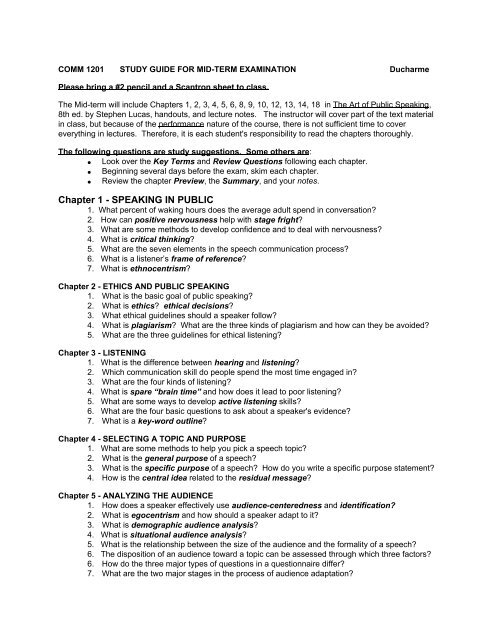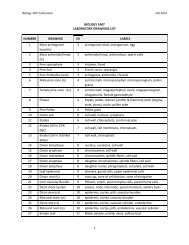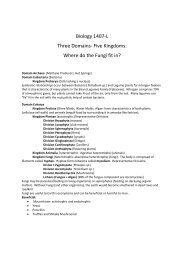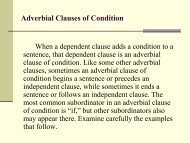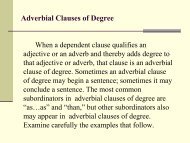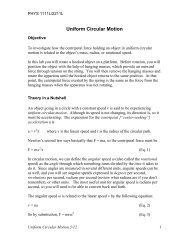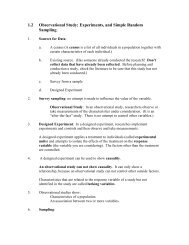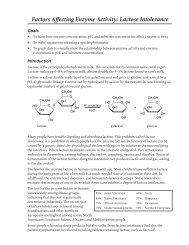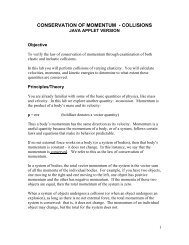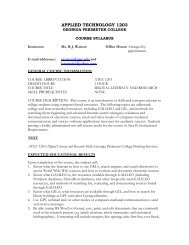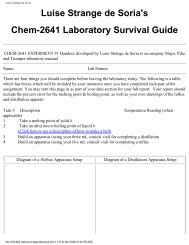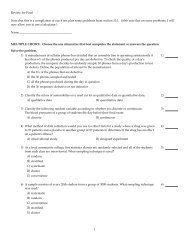Chapter 1 - SPEAKING IN PUBLIC
Chapter 1 - SPEAKING IN PUBLIC
Chapter 1 - SPEAKING IN PUBLIC
You also want an ePaper? Increase the reach of your titles
YUMPU automatically turns print PDFs into web optimized ePapers that Google loves.
COMM 1201 STUDY GUIDE FOR MID-TERM EXAM<strong>IN</strong>ATION Ducharme<br />
Please bring a #2 pencil and a Scantron sheet to class.<br />
The Mid-term will include <strong>Chapter</strong>s 1, 2, 3, 4, 5, 6, 8, 9, 10, 12, 13, 14, 18 in The Art of Public Speaking,<br />
8th ed. by Stephen Lucas, handouts, and lecture notes. The instructor will cover part of the text material<br />
in class, but because of the performance nature of the course, there is not sufficient time to cover<br />
everything in lectures. Therefore, it is each student's responsibility to read the chapters thoroughly.<br />
The following questions are study suggestions. Some others are:<br />
• Look over the Key Terms and Review Questions following each chapter.<br />
• Beginning several days before the exam, skim each chapter.<br />
• Review the chapter Preview, the Summary, and your notes.<br />
<strong>Chapter</strong> 1 - <strong>SPEAK<strong>IN</strong>G</strong> <strong>IN</strong> <strong>PUBLIC</strong><br />
1. What percent of waking hours does the average adult spend in conversation<br />
2. How can positive nervousness help with stage fright<br />
3. What are some methods to develop confidence and to deal with nervousness<br />
4. What is critical thinking<br />
5. What are the seven elements in the speech communication process<br />
6. What is a listener’s frame of reference<br />
7. What is ethnocentrism<br />
<strong>Chapter</strong> 2 - ETHICS AND <strong>PUBLIC</strong> <strong>SPEAK<strong>IN</strong>G</strong><br />
1. What is the basic goal of public speaking<br />
2. What is ethics ethical decisions<br />
3. What ethical guidelines should a speaker follow<br />
4. What is plagiarism What are the three kinds of plagiarism and how can they be avoided<br />
5. What are the three guidelines for ethical listening<br />
<strong>Chapter</strong> 3 - LISTEN<strong>IN</strong>G<br />
1. What is the difference between hearing and listening<br />
2. Which communication skill do people spend the most time engaged in<br />
3. What are the four kinds of listening<br />
4. What is spare “brain time” and how does it lead to poor listening<br />
5. What are some ways to develop active listening skills<br />
6. What are the four basic questions to ask about a speaker's evidence<br />
7. What is a key-word outline<br />
<strong>Chapter</strong> 4 - SELECT<strong>IN</strong>G A TOPIC AND PURPOSE<br />
1. What are some methods to help you pick a speech topic<br />
2. What is the general purpose of a speech<br />
3. What is the specific purpose of a speech How do you write a specific purpose statement<br />
4. How is the central idea related to the residual message<br />
<strong>Chapter</strong> 5 - ANALYZ<strong>IN</strong>G THE AUDIENCE<br />
1. How does a speaker effectively use audience-centeredness and identification<br />
2. What is egocentrism and how should a speaker adapt to it<br />
3. What is demographic audience analysis<br />
4. What is situational audience analysis<br />
5. What is the relationship between the size of the audience and the formality of a speech<br />
6. The disposition of an audience toward a topic can be assessed through which three factors<br />
6. How do the three major types of questions in a questionnaire differ<br />
7. What are the two major stages in the process of audience adaptation
<strong>Chapter</strong> 6 - GATHER<strong>IN</strong>G MATERIALS<br />
1. What is the difference between the Catalogue and Periodical Databases<br />
2. Review library, research and online terms.<br />
3. What are the five important resources for doing library research<br />
4. What are some Reference Works that can help you prepare speeches<br />
5. What are the three major kinds of search aids<br />
6. What three criteria are used to evaluate Internet documents<br />
7. What is the research interviewer's most important pre-interview task What about taping<br />
8. What are some helpful tips for doing research<br />
<strong>Chapter</strong> 8 - ORGANIZ<strong>IN</strong>G THE BODY OF THE SPEECH<br />
1. Using strategic organization, which of the three basic parts of a speech is prepared first<br />
2. How many main points are recommended<br />
3. Your choice of effective speech order depends upon which three things<br />
4. What are the five basic patterns of organization used most often by public speakers<br />
5. What are some basic tips for preparing main points in a speech<br />
6. What are the four types of speech connectives and how can they help join ideas together<br />
<strong>Chapter</strong> 9 - BEG<strong>IN</strong>N<strong>IN</strong>G AND END<strong>IN</strong>G THE SPEECH<br />
1. What are the four objectives of a speech introduction<br />
2. What are some methods to get audience attention and interest<br />
3. What is a rhetorical question credibility goodwill preview statement<br />
4. What are some tips for preparing the speech introduction<br />
5. What are the two main functions of a speech conclusion<br />
6. What methods can be used to reinforce the central idea<br />
7. What type of speech may conclude with an appeal for action<br />
8. What are some Tips for Preparing the Conclusion<br />
<strong>Chapter</strong> 10 - OUTL<strong>IN</strong><strong>IN</strong>G THE SPEECH<br />
1. What are some guidelines for the preparation outline and the visual framework<br />
2. What characterizes a good speech title<br />
3. What are some guidelines for the speaking outline<br />
<strong>Chapter</strong> 12 – DELIVERY (Methods & Non-Verbal)<br />
1. What are the essential differences among the four basic methods of delivering a speech<br />
2. Which method is most widely recommended for public-speaking students<br />
3. What is good delivery nonverbal communication conversational quality kinesics<br />
4. When a speaker's body language contradicts his words, which will listeners tend to believe<br />
5. What is one of the easiest and most effective things you can do to improve your image<br />
5. What are the three elements of P.E.P. [Posture, Eye contact, Projection]<br />
6. Review suggestions for practicing delivery<br />
7. What are some suggestions for handling the Question-and-Answer Session<br />
<strong>Chapter</strong> 13 - US<strong>IN</strong>G VISUAL AIDS<br />
1. What are some advantages of using visual aids in speeches<br />
2. What are some kinds of visual aids that may be used<br />
3. What are some guidelines for preparing visual aids<br />
<strong>Chapter</strong> 14 - <strong>SPEAK<strong>IN</strong>G</strong> TO <strong>IN</strong>FORM<br />
1. What are the three general criteria by which informative speeches will be judged<br />
2. What are the four types of informative speeches<br />
3. What are the difference among the four methods of organization<br />
4. Recognize the guidelines for informative speaking and their implications for a speaker.<br />
<strong>Chapter</strong> 18 - <strong>SPEAK<strong>IN</strong>G</strong> <strong>IN</strong> SMALL GROUPS<br />
1. What are the different types of leadership in small groups<br />
2. What are the responsibilities of members in a small group<br />
3. What are the five steps of the Reflective Thinking Method consensus<br />
4. What is the difference between a symposium and a panel discussion Lucas 8ed


